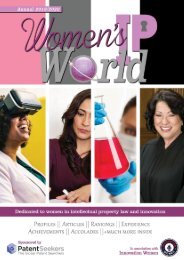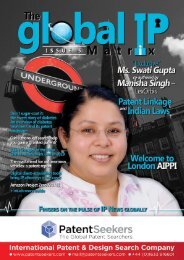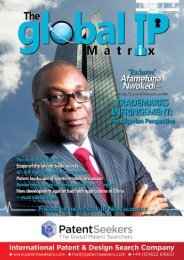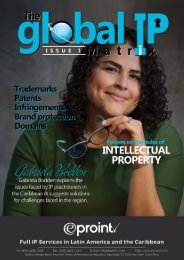Global IP Matrix - Issue 8
Dear Readers We are delighted to present you with issue 8 of The Global IP Matrix magazine! Once again, we have fantastic content delivered to you by industry professionals who are experts in their field. This issue explores IP & Innovation in Africa, anti-counterfeiting measures in the Caribbean, IPR Infringement in China, plus many more engaging articles around the IP ecosystem. It's been a challenging few months; however, we are grateful that our clients and contributors share our vision. Together, we are heading for better times. We cannot thank our authors enough for their time and efforts to keep you, our audience up to date with news and stories from their own perspective and expertise. Look out for our next edition, in January 2021 and until then, stay safe, healthy & happy. Elvin Hassan – Editor
Dear Readers
We are delighted to present you with issue 8 of The Global IP Matrix magazine!
Once again, we have fantastic content delivered to you by industry professionals who are experts in their field.
This issue explores IP & Innovation in Africa, anti-counterfeiting measures in the Caribbean, IPR Infringement in China, plus many more engaging articles around the IP ecosystem.
It's been a challenging few months; however, we are grateful that our clients and contributors share our vision. Together, we are heading for better times.
We cannot thank our authors enough for their time and efforts to keep you, our audience up to date with news and stories from their own perspective and expertise.
Look out for our next edition, in January 2021 and until then, stay safe, healthy & happy.
Elvin Hassan – Editor
Create successful ePaper yourself
Turn your PDF publications into a flip-book with our unique Google optimized e-Paper software.
THE WOMEN'S IP WORLD ANNUAL 2021
ANTI-COUNTERFEITING
MEASURES IN THE CARIBBEAN:
THE DEMAND FOR
UNIFIED MEASURES
The world is witnessing ongoing
globalisation, which has hauled
benefits and challenges. On the one
hand, the increasing globalisation,
access to new technologies, and global
and multilateral trade agreements
that have come to reduce taxes and
barriers considerably have made
international trade progressively
affordable and straightforward for
everyone. The rise of international
trade is not in dispute. This,
undoubtedly, translates into a
benefit for brands that can reach
all countries in the world regardless
of their location. However, just as
they benefit, they also face the great
challenge of counterfeiting. It is a
fact that globalisation has made the
commercialisation of counterfeit
products easier.
That said, it is necessary to put into force
effective legislations to respond to the
commercialisation of counterfeit products.
For that reason, this article focuses on current
antipiracy practices in the Caribbean region.
Additionally, the article will expose the different
measures that trademarks can and should
apply to safeguard their intangible assets as
well as the situation of some Caribbean islands.
Finally, the need for uniform legislation in this
regard is also noted.
I. The ABC to
counterfeiting
The Agreement on Trade-related Aspects
on Intellectual Property Rights (the TRIPs
Agreement) defines counterfeiting as the act of
trading goods bearing a registered trademark
without authorisation. It also includes the case
in which a product is imitated. Likewise, it
applies to copyrights in which songs, movies,
literary works, among others, are distributed
without authorisation and without paying
royalties nor another fee involved. In general,
the intent may be to deceive consumers on the
origin of the product. However, in the case of
well-known brands, the intent might not be
to deceive; in this case, consumers purchase
goods at a lower price and expect an inferior
quality product. Similar is the case of pirated
copyright goods in which, usually, the enduser
is aware of the illegality of the product.
In all cases, counterfeiting is an illegal act that
brings adverse effects to Intellectual Property
Rights (IPR) holders. With that in mind,
countries around the world need to join forces
to work against counterfeiting.
It is relevant to point out that counterfeiting has
always existed. One of the first counterfeitings
in history dates back to the 5th century under
the rule of Emperor Justinian. However, to
date, it is commonly said that the world is
facing a new generation of counterfeiters who
have created sophisticated systems to distribute
and sell their products in a clandestine way.
Likewise, it is difficult to distinguish the
illegal goods because modern counterfeiters
have shaped the known “real fakes,” meaning
that the product is a high-quality copy. As a
result, the new unlawful mechanisms make it
more difficult for brand owners and customs
authorities to detect and track counterfeit
goods.
32 www.gipmatrix.com
Written by Laura Castillo Sepúlveda Partner at
INNVENTIVA -Espacio Legal www.innventivalegal.com
II. A strategic view to
combat counterfeiting
Having explored counterfeit and how it affects
IPR owners, it is essential to study the different
strategies and actions available.
Firstly, it is crucial that brand owners must
count with a strong, tailor-made, and
strategic IP portfolio. In other words, brand
owners should have all their intangible
assets registered within all the countries they
commercialise their goods. They should
also consider registering their trademarks in
countries where there is a risk of distribution
of counterfeit products.
In that regard, it is essential to highlight that
while some countries like the Dominican
Republic, Jamaica, and Trinidad and Tobago
are ‘first to file’ jurisdictions, other countries
like Suriname have a ‘first to use’ system. In the
former case, IPRs start with the registration;
hence, brands need to register their IP assets
with priority in those jurisdictions. In the
latter, rights are acquired by use in commerce.
However, if there is a conflict pertaining to a
similar trademark, it is usually quite difficult
to prove that one was indeed the first to use it.
When it is not clear who is the first to use a
trademark, the registration date could also be
one factor that the courts weigh to determine
who is first to use and, therefore, can be
considered the owner. Thus, even though
JOIN OUR
NETWORK
TODAY
THE ONLY PRINT,
DIGITAL & AUDIO
PUBLICATION
CELEBRATING WOMEN
IN IP, IP LAW &
INNOVATION
GLOBALLY.
Official sponsors
Profiles - Rankings - Accolades - Experience - Awards - Achievements + much more
The Women's IP World Annual is the only print, digital, and audio annual digital publication highlighting
women's essential roles in the IP and Innovation sector. We are currently researching representatives working
at all levels in the industry to join our fantastic network of influential women from all over the world.
Contact us today to find out more about our profile, editorial, and advertisement packages at
info@womensipworld.com or call +44 (0)203-813-0457
www.womensipworld.com












